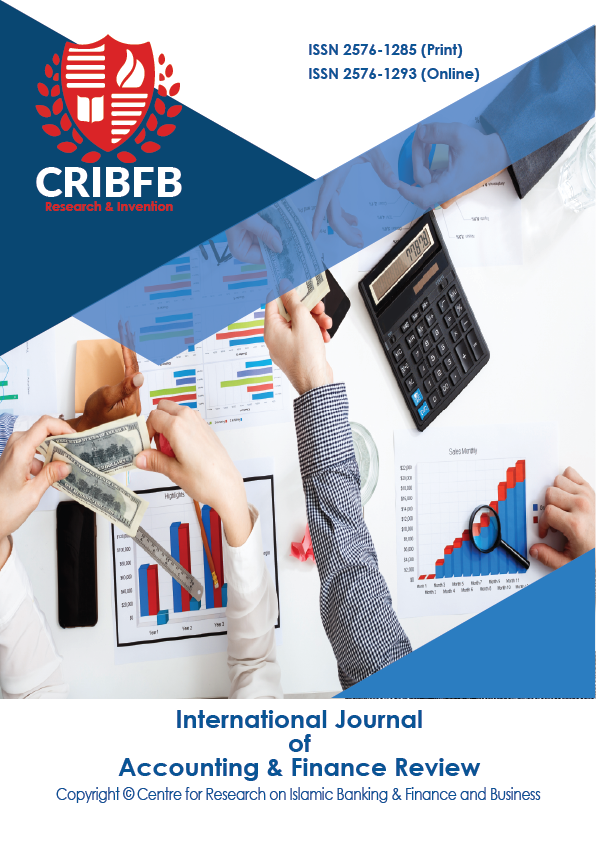The Measure of Financial Stability and its Impact on Foreign Direct Investment: Evidence from BRIC Nations
Main Article Content
Abstract
The stability of the economy has explicitly become a key objective for fiscal, economic, and monetary policy. It is a broader term described by different aspects of finance and the financial system. One variable cannot be recognized for defining and achieving stability. The purpose of this paper is two-fold, one to construct four measures of financial stability (MFS). The second purpose is to use the four constructed measures of financial stability in two stage least square (TSLS) regression framework to know the impact of MFA on Foreign Direct Investment (inwards) of BRIC for a period from 2000-2017. In case of Brazil, all the four measures of financial stability are significant. In case of Russia, government finances are not appropriately managed. In case of China, the large inflow of FDI is because of government policies as rest of the measures are negative. In case of India, the government measures are not efficient to attract the FDI.The openness of the economy is positively contributing to FDI in all countries except India. Of all the four nations Brazil is on the right path.
JEL Classification Codes: F4, F6, H11, E60.
Downloads
Article Details
Section
How to Cite
References
Al-Tarawneh, A., & Khataybeh, M. (2016). Impact of Monetary Policy on Financial Stability Evidence from Jordan = أثر السياسة النقدية في الاستقرار المالي في الأردن. Dirasat Administrative Sciences, 43(1), 301–313. https://doi.org/10.12816/0028464
Aspachs, O., Goodhart, C., Segoviano, M., Tsomocos, D., Zicchino, L., Group, F. M., & Industry, F. (2006). Searching for a Metric for Financial Stability. Lse Financial Markets Group Special Paper Series, 167, 1–38.
Bank for International Settlements. (2010). Macroprudential policy tools and frameworks. Update to G20 Finance Ministers and Central Bank Governors. Financial Stability Board.
Beck, T., & Levine, R. (2004). Stock markets, banks, and growth: Panel evidence. Journal of Banking and Finance. https://doi.org/10.1016/S0378-4266(02)00408-9
Borio, C. E. V., & Drehmann, M. (2011). Towards an Operational Framework for Financial Stability: “Fuzzy” Measurement and Its Consequences. SSRN Electronic Journal, 284. https://doi.org/10.2139/ssrn.1458294
Cecchetti, S. G., & Kharroubi, E. (2012). Reassessing the impact of finance on growth. BIS Working Paper.
Cheang, N., & Choy, I. (2011). Aggregate Financial Stability Index for an Early Warning System. 27–51.
Creel, J., Hubert, P., & Labondance, F. (2015). Financial stability and economic performance. Economic Modelling. https://doi.org/10.1016/j.econmod.2014.10.025
Daniel, B. C., & Jones, J. B. (2007). Financial Liberalization and Banking Crises in Emerging Economies. Journal of International Economics, 72(1), 202–21.
Enowbi, M. B., & Kupukile, M. (2012). Financial instability, financial openness and economic growth in african countries. University of Westminster, African Development Bank, (43340).
Erturk, K. A. (2005). Economic Volatility and Capital Account Liberalization in Emerging Countries. International Review of Applied Economics, 19(4), 399–417.
Fell, J., & Schinasi, G. (2005). Assessing financial stability: Exploring the boundaries of analysis. National Institute Economic Review, 192(1), 102–117. https://doi.org/10.1177/002795010519200110
Goodhart, C. A. E., Sunirand, P., & Tsomocos, D. P. (2005). A model to analyse financial fragility. Economic Theory. https://doi.org/10.1007/s00199-004-0572-7
Härdle, W., & Hlávka, Z. (2007). Multivariae Statistics: Excercise and Solutions.
Hatzius, J., Hooper, P., Mishkin, F., Schoenholtz, K. L., & Watson, M. W. (2010). Financial Conditions Indexes : A Fresh Look after the Financial Crisis. NBER Working Paper, No. 16150(0340-5761 LA-eng), 652–660. https://doi.org/10.2139/ssrn.315489
Hansen, L. P. (1982). Large sample properties of generalized method of moments estimators. Econometrica: Journal of the Econometric Society, 1029-1054.
Houben, A., Kakes, J., & Schinasi, G. (2004). Toward a Framework for Safeguarding Financial Stability. IMF Working Papers, 04(101), 1. https://doi.org/10.5089/9781451852547.001
Johnston, R. B., Schumacher, L., & Chai, J. (2000). Assessing Financial System Vulnerabilities. IMF Working Papers. https://doi.org/10.5089/9781451849868.001
https://doi.org/10.5089/9781451849868.001
Jolliffe, I. T. (1972). Discarding Variables in a Principal Component Analysis. I: Artificial Data. Applied Statistics. https://doi.org/10.2307/2346488
Jolliffe, I. T. (1973). Discarding Variables in a Principal Component Analysis. II: Real Data. Applied Statistics. https://doi.org/10.2307/2346300
Kaiser, H. F. (1960). The Application of Electronic Computers to Factor Analysis. Educational and Psychological Measurement. https://doi.org/10.1177/001316446002000116
Kaminsky, G. L., & Schmukler, S. L. (2008). Short-Run Pain, Long-Run Gain: Financial Liberalization and Stock Market Cycles. Review of Finance, 12(2), 253–92.
Katchova, A. (2013). Instrumental Variables. https://doi.org/10.1097/01.ede.0000215160.88317.cb
Kim, E. H., & Singal, V. (2000). The Fear of Globalizing Capital Markets. Emerging Markets Review, 1(3), 183–98.
Moody’s. (2013). Moody’s Statistical Handbook Country Credit (Issue November).
Roy, I., Biswas, D., & Sinha, A. (2015). Financial Conditions Composite Indicator ( FCCI ) for India. Indicators to Support Monetary and Financial Stability Analysis : Data Sources and Statistical, 7(IFC Bulletin 39).
Stock, J. H., & Yogo, M. (2005). Testing for weak instruments in Linear Iv regression. In Identification and Inference for Econometric Models: Essays in Honor of Thomas Rothenberg. https://doi.org/10.1017/CBO9780511614491.006
Tsomocos, D. P. (2003). Equilibrium analysis, banking and financial instability. Journal of Mathematical Economics. https://doi.org/10.1016/S0304-4068(03)00045-4
Tsomocos, D. P. (2005). Equilibrium Analysis, Banking, Contagion and Financial Fragility. SSRN Electronic Journal. https://doi.org/10.2139/ssrn.381140
Van den End, J. W. (2006). Indicator and boundaries of financial stability. DNB Working Paper.




